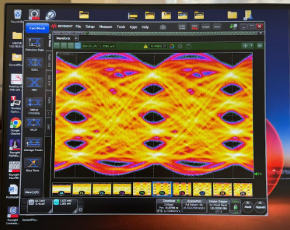Technology Based Products
What is a complete technology platform?
The materials are just the starting point. In order to take advantage of the capabilities of the innovative EO polymers fully, the company has developed a complete toolkit of compatible elements including:
- Device designs that bring electrical and optical signals together efficiently
- Ancillary materials to be used in devices to maintain low optical and electrical loss and high signal fidelity
- Fabrication processes approved for compatibility with polymers and ancillary materials
- Accurate metrology specific to polymers
What are the benefits of vertical integration?
Having the modulator and integrated circuit development in-house has informed the materials development direction and vice versa. This vertically integrated business model enables a superior platform by aligning the design for manufacturability from materials to complex circuits. With the recent expansion of our Lightwave Logic facility, now operational with an additional nearly 10,000 sq ft adjoining our current space—a 70% increase in available space—fully utilized for manufacturing test and analysis, we achieve the following benefits:
- Increased complexity of designs
- Optimized power consumption
- Reduced cost
High-speed Modulator Leveraging Electro-optic Polymer
In addition to innovating the EO polymer materials, Lightwave Logic takes its technology platform to the next level by developing ancillary materials and processes. These elements are brought together and demonstrated in advanced high-speed optical modulators.
The polymer is spun onto silicon wafers and standard microfabrication techniques are used to deposit and pattern metal electrodes and optical waveguides.
One well-known optical modulator device is the Mach-Zehnder interferometer. The light output is changed by changing the relative phase between the two arms. One common trick to double the effect for the same available drive voltage is to drive the two arms in opposite directions (push-pull mode). Polymers have an interesting advantage over most other electro-optic materials which are crystalline. The direction of polymer’s electro-optic activity is entirely determined by the direction of the applied poling field. By poling the two arms of the Mach-Zehnder in opposite directions, the resulting device automatically has push-pull operation with a single applied signal.
Push-pull Mach-Zehnder Modulator
Once the modulator chip is made, it is packaged for mechanical protection and also to ensure signal quality for electrical and optical connections.
Below is a polymer optical modulator with >60 GHz bandwidth packaged with high-speed electrical connectors and optical pigtails.
Photonic Integration Platform Technology
Inspired by the remarkable record of integrated microelectronics, the opto-electronics industry has great interest in developing photonic integrated circuits (PICS). Photonics refers to devices that manipulate photons—that is, light—rather than electrons.
Even the best individual devices can be made more functional by integrating many together. Integration has many benefits, the most notable being dramatic improvements in size and cost. Yet, photonic integration has only recently come into the spotlight. The primary applications for photonics used to require stand-alone, high performance components such as used for long-haul telecom.
Now, photonic integration has suddenly come into the spotlight as electronic interconnects struggle to keep up with speed increases of electronic chips. Photonics is being looked at to replace electronics in already highly integrated applications such as chip interconnect. Co-packaging of electronics integrated circuits (ICs) with photonic interconnect, considered unlikely a few years ago, is now viewed by many as inevitable. However, this requirement poses new challenges that are acknowledged as difficult and that new technologies will be required to meet them.
P2IC™ (Polymer Photonic Integrated Circuits) are ideally positioned to be one of these new technologies. Lightwave Logic’s devices are made using conventional wafer-scale processing such as used for microelectronics and therefore similarly capable of being integrated. In addition, the polymer microfabrication processes are compatible with other materials platforms such as Silicon Photonics and Indium Phosphide which are now starting to become more integrated. In particular, the Silicon Photonics ecosystem has recently accepted that its roadmap will include adding more and more materials, each for their specific benefits. EO polymers’ speed and voltage advantages are attractive additions to this ecosystem.







